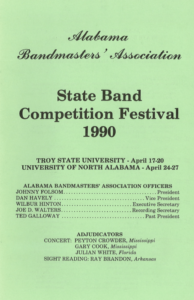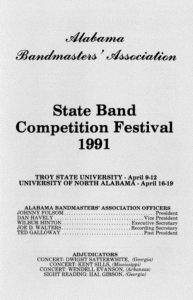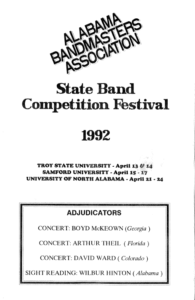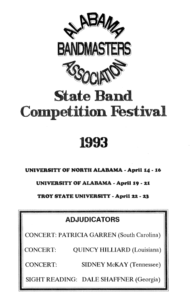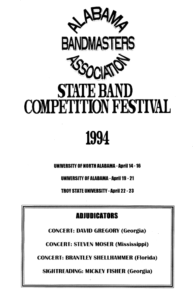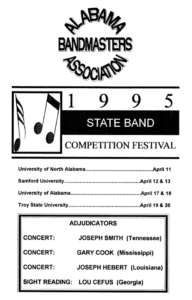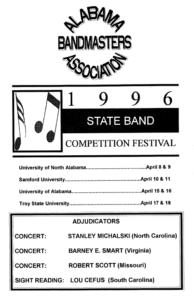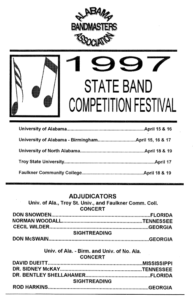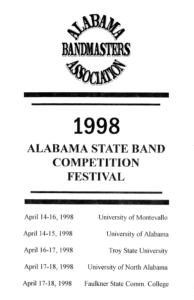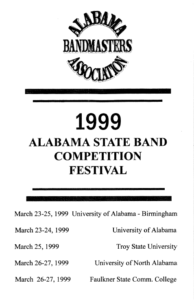1940‘s – 1950‘s – 1960‘s – 1970‘s – 1980‘s – 1990‘s – 2000‘s – 2010‘s – 2020‘s
During the 1990s, the number of sites for “State Contest” continued to expand. The percentage of bands awarded “Superior” ratings began to trend upward dramatically. An eventual switching of the dates for this event and the All-State Festival would set the stage for a move to a one-tiered competition-festival.
Enjoy this portion of the story of Alabama’s school band movement and the members of the Phi Beta Mu Hall of Fame who helped shape it.
Click the year or the program cover to open a PDF of the printed program.
1990
This year, Hall of Fame member Tony Pike made his debut at the competition-festival with his Opp High School band.
The distribution of ratings of the 113 bands is as follows:
- Superior 37 (31%)
- Excellent 68 (60%)
- Good 9 (9%)
- Fair 0 (0%)
1991
The distribution of ratings of the 113 bands is as follows:
- Superior 23 (22%)
- Excellent 58 (55%)
- Good 25 (23%)
- Fair 0 (0%)
1992
This year’s competition-festival moved back to three sites: Troy, Florence, and Tuscaloosa. One panel continues to be used throughout the state. The distribution of ratings of the 114 bands is as follows:
- Superior 32 (28%)
- Excellent 67(59%)
- Good 14 (12%)
- Fair 1 (1%)
1993
Even though the competition-festival is spread across three sites and eight days, a single panel continues to hear every band, assuring better consistency throughout the state.
The distribution of ratings of the 130 bands is as follows:
- Superior 31 (24%)
- Excellent 56 (43%)
- Good 40 (31%)
- Fair 3 (2%)
This year was especially rigorous. While the percentage of “Superior” ratings awarded did not differ dramatically (down 4 percentage points), the percentage of “Good” ratings almost tripled from the previous year.
1994
The distribution of ratings was quite different this year. Of the 113 bands, the breakdown is as follows:
- Superior 60 (53%)
- Excellent 49 (43%)
- Good 4 (4%)
- Fair 0 (0%)
1995
The move from a competition-festival at the state level to eight festivals at the district level took another step this year. Three sites expanded to four: the University of North Alabama, Samford University, the University of Alabama, and Troy State University.
Of the 114 bands, the breakdown is as follows:
- Superior 58 (51%)
- Excellent 54 (47%)
- Good 2 (2%)
- Fair 0 (0%)
1996
Participation in this year’s competition-festival grew to 134 bands across four sites. The distribution of ratings is as follows:
- Superior 89 (66%)
- Excellent 41 (31%)
- Good 4 (3%)
- Fair 0 (0%)
1997
From its inception, the ABA State Competition-Festival had been one where a single panel of judges listened to all bands in the state from a given classification. During its years at the University of Alabama, two panels would run simultaneously over three days. One panel would listen to the young bands and smaller high schools while the other would listen to larger high schools. When the event divided into multiple locations, a single panel traveled to each site. Every “Class A” band, for example, would play for the same panel.
This year, the event was spread across five locations. One panel listened to bands at the University of Alabama, Troy, and Faulkner. The other panel listened to bands at UAB and the University of North Alabama. On any given day, performances happened at two different sites. As we look back, this further expansion in the number of sites and multiple panels further paves the way for the event to be moved to the district level.
While we have the printed program, it unfortunately contains only a handful of ratings.
1998
This year’s festival continued across five sites: Alabama, Montevallo, Troy, North Alabama, and Faulkner. One panel of adjudicators listened to bands at Montevallo and North Alabama while a second listened to bands at Alabama, Troy, and Faulkner.
The distribution of ratings of the 138 bands is as follows:
- Superior 92 (67%)
- Excellent 45 (33%)
- Good 1 (1%)
- Fair 0 (0%)
1999
This year’s competition-festival continued the five-site, two-panel model. One significant change this year can be seen as the final step in the progression from the state-level festival, as it was known for almost five decades, to the event being held at the district level with no qualifying festival.
Traditionally, the ABA All-State Festival was a March event. The ABA State Competition-Festival was held in April. Beginning this year, the two events flipped. The ABA State Competition-Festival moved to March. All-State moved to April.
This change meant less time between the district festival and “state.” The opportunity for improvement between the two events was lessened. We saw cases where the registration deadline for the state competition-festival passed before the qualifying district festival had even been held.
The distribution of ratings of the 146 bands is as follows:
- Superior 87 (60%)
- Excellent 54 (37%)
- Good 5 (3%)
- Fair 0 (0%)
